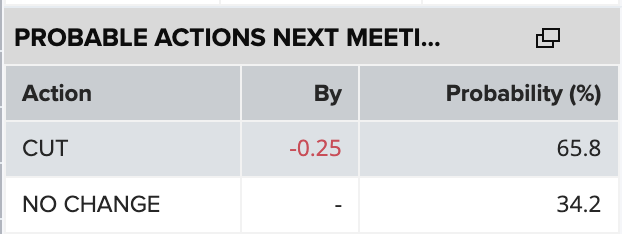US Dollar holds its ground as markets await Powell’s speech at Jackson Hole
The US dollar recovers some momentum after market pricing shows less likelihood of a Fed cut in September, Powell's speech in focus for more clues
The U.S. dollar is holding steady at stronger levels ahead of Federal Reserve Chair Jerome Powell’s much-anticipated speech at the Jackson Hole Economic Symposium later today. Traders are reassessing the outlook for interest rates, keeping currency markets cautious but tilted in favour of the greenback.
The U.S. dollar index (DXY) has climbed to around 98.3, up nearly 1% on the week, reversing two consecutive weeks of losses. The move reflects a recalibration of expectations: investors are now pricing in a 65% chance of a 25-basis point rate cut in September, down from 85% a week earlier. This shift has helped underpin demand for the dollar.

Source: refinitiv
Earlier softness in U.S. jobs data had briefly stoked hopes of a larger 50bps cut in September, but inflation concerns, and more measured Fed commentary have tempered those views. It is unlikely that Powell will pre-commit to a rate cut path, preferring instead to stress policy flexibility. This stance reduces the odds of an aggressive easing path, supporting the dollar’s resilience.
The dollar’s firmness has come at the expense of its major peers. The euro and pound have slipped over the past week, alongside the yen, which has weakened further, pressured by the widening U.S.-Japan yield gap. Commodity-linked currencies such as the Australian and New Zealand dollars have also retreated, with the Kiwi underperforming after dovish signals from the Reserve Bank of New Zealand.
Technically, the dollar is trading just above its 50-day moving average, consolidating in a narrow range. Powell’s remarks could be a potential breakout catalyst, with a hawkish tone possibly sending the index toward the 98.50–100 zone, whilst a dovish tilt, reviving expectations of larger or earlier cuts, might push it back below 97.
US dollar Index (DXY) daily chart

(Past performance is not a reliable indicator of future results)